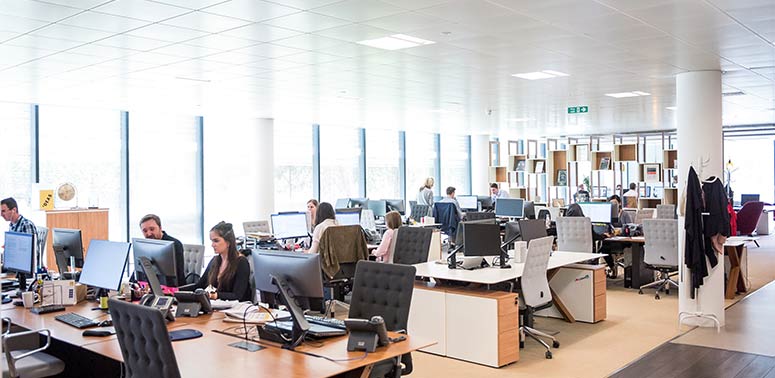By Nina Rowley | 28 February 2023
I really enjoy my work…now! It certainly wasn’t always like this. In this blog, I’ll share my perspective on why attention deficit hyperactivity disorder (ADHD), especially undiagnosed adult ADHD creates significant challenges in the workplace and how working practices and awareness need to be addressed in order to be more inclusive of those with ADHD.
Knowledge isn’t power until it is applied.
― Dale Carnegie
A shift in mindset
I’d like to highlight the importance of understanding how your own mind works and the need for us all to learn the facts and not myths about brain differences. This shift in mindset would enable neurodiverse* people to embrace and celebrate who they are without shame and be open about the adjustments they need to make in order to perform well in the workplace.
Knowledge, acceptance and reasonable adjustments will help neurodiverse people to not only survive in a neurotypical environment but actually thrive! This would be a win-win outcome for everyone.
I’ll also touch upon the challenges and glorious benefits of raising a daughter who has a combined type of ADHD. I’ll share some tips and tools that have helped me to work more consistently with ADHD.
Finally, I’ll share signposting and publication links that you may find helpful to learn more about this topic.
ADHD is a behavioural disorder with three key aspects, inattention, hyperactivity, and impulsivity, (APA 2013) which interfere with a child or young person’s functioning or development. It’s a long-term condition with symptoms that start in young children (under 12 years old) but often persist into adult life.
- The Association of Child and Adult Mental Health.
Learn more about the definition of ADHD. *Neurodiverse is a term often used to describe people with autism and ADHD as well as some other atypical conditions. Read more about the use of the term neurodiverse.
ADHD in women and girls may be missed during childhood
There is research that suggests that ADHD in women and girls may be missed during childhood, and may not be diagnosed until adulthood. This is because ADHD tends to present differently in boys and girls. Girls may be more inattentive, whereas boys tend to be more hyperactive and/or impulsive.
Hyperactive and impulsive behaviour is likely to be more disruptive in the classroom and at home, therefore investigated much earlier than a girl presenting with mainly inattentive traits. A girl might be perceived as simply a shy and forgetful daydreamer. You can learn more about the presentation of ADHD in the different sexes in the following three publications:
- Females with ADHD
- Do different factors influence whether girls versus boys meet ADHD diagnostic criteria?
- ADHD in girls and women: a call to action-reflections
There appears to be a lot of misunderstanding around what ADHD is and isn’t. Yes, everyone loses track of time, forgets things or interrupts a conversation without meaning too.
Everyone sometimes forgets what they were going to say, or becomes overwhelmed in busy environments, or has trouble focusing on, prioritising or even starting tasks. However, when these things happen many times a day, every single day, since childhood, there is a problem! Please read this article by Prof. Amanda Kirby who helps to dispel myths about ADHD
Neurodiversity in the workplace: How does that work?
All education settings and places of work stand to gain from learning more about the benefits that neurodiverse people can offer. Some workplace sectors have known about the pool of non-linear thinking talent for decades and have active neurodiverse recruitment programs to harness their skills.
By adopting a neurodiversity framework… There will also be a focus on uncovering the strengths and talents of neurodiverse people – either those that may be linked closely to their condition (e.g., creativity and energy in ADHD; an eye for detail and orderly thinking in ASD) or obscured by it under normal circumstances…. there will be a strong interest in understanding the attitudes of neurotypical individuals and organisations towards neurodiverse people and how these create risks for stigma, low self-esteem and mental health problems
Sonuga-Barke, E., & Thapar, A. (2021). The neurodiversity concept: is it helpful for clinicians and scientists? The Lancet Psychiatry, 8(7), 559-561.
The solution for inclusivity is placed on the environment rather than the neurodiverse person. The need to adapt the environment of schools, colleges, universities and workplaces to make them more neurodiverse friendly, in addition to a constructive approach to changing the attitudes of neurotypical people is clear.
The tech industry were early adopters and now banks, consulting firms, law firms, charities, NGO’s, Universities and their amazing research centres, among many others are realising the need to actively encourage and support neurodiverse employees.
Personally, I have consistently found it problematic to work in an office, gallery, classroom or anywhere else where many colleagues sit together, talk on the phone and to each other in passing. Going into the same place every day was stifling and trying to keep up with schedules was challenging.
I didn’t understand why I found this so incredibly exhausting, I now understand that ADHD is not so much a deficit of attention, rather an inability to narrow down focus at will to the task. Conversely people with ADHD can often experience hyper-focus and are extremely productive when they are really interested in a subject.
ADHD is not so much a deficit of attention, rather an inability to narrow down focus at will to the task. Conversely people with ADHD can often experience hyper-focus and are extremely productive when they are really interested in a subject.
Every small noise is a distraction and consequently I found that most shared office spaces were stressful to work in and often stayed late to complete work when it was quieter. In my previous life as a gallery manager, I would shut myself into the storage cupboard at length, to focus on accounts, reports and exhibition planning due to the ad hoc interruptions of curious visitors, and chatty gallery staff.
Working from home for the last six years has been a revolution! I can control my working environment, keep it quiet with headphones, take movement breaks when needed, tap my feet, twiddle my hair, info dump on planners and post it notes as thoughts pop up. I set multiple reminders on a watch and smart device to prevent forgetting tasks. It gives me the space to be much more productive. I miss connecting with people in-person, but when I do, I appreciate this time to meet and discuss. Working from home is wonderful when the children are in school. However, if they are at home whilst I try to work, it is futile.

Workplaces can help staff with ADHD by offering the following adjustments
- Flexibility to work at home or in a separate quiet space, particularly for more involved tasks.
- Written/emailed instructions in addition to verbal ones. It is very hard to follow instructions verbally after the first step.
- Breaking down large projects into smaller more manageable phases of work.
- Checking in that the person in the physical or online meeting has the information they need, in case they unintentionally ‘zoned out’ during the meeting.
- Keep meetings briefer and to the point; reiterating the main points at the end.
- Giving clarity about who is doing what and what they are contributing and when. Being expected to ‘read between the lines’ is confusing.
- Offering opportunities to check in as projects progress.
Working tools that people with ADHD may find helpful
- Lists - I do love a list! Before opening emails in the morning, look at your list, check yesterday’s list and see what needs to be brought over. You might even enjoy crossing things off!
- Prioritise. Not everything is actually important, although your brain may pretend that it is.
- Headphones: some people find it helps to have white noise or music playing when doing more mundane tasks or use headphones simply to block out external noise.
- Timer – Ideally a visual analogue timer that counts down from an hour. Then try using a variation of the Pomodoro technique to tackle work in short blasts.
- Movement breaks, in whatever form works for you, stretching, walking, or even star jumps.
- Physical weekly and/or monthly planner – keep your plans physical and visual, try colour coding for different types of tasks.
- Reminders can be set on a smart home device, phone or a watch with a timer. This helps to keep you on track and fight time blindness, it also helps to prevent ruined meals!
- Post it’s Try using different colours for work and home tasks. Write your thoughts down as they come up, that makes it easier to put the thought somewhere else and move on.
- Things to fidget with can help to regulate your focus whilst working.
- Have water where you can see it to help you remember to drink regularly.
- Eat regularly! Build this into your plan and create a reminder.
Parenting a child with a combined type of ADHD
I was raised in an eclectic neurodiverse working class family. My only brother is autistic and attended a school for children with special learning needs from the age of six. He still lives at home for support, although he has always worked part time.
My uncle on my mother’s side is also autistic but he presents quite differently. He was happily married (now widowed) and has two children as well as having had a very successful career as a scientist. My father had severe dyslexia. It is understood that neurodiverse conditions are heritable and are also influenced by environmental factors.
When my younger daughter was a baby I noticed that it took her a very long time to fall asleep. I also noticed that she had very strong reactions and over reactions to her environment. She was fearless and prone to running off suddenly. She was always an intense and often explosive child, who felt all her feelings deeply.
As I helped her to prepare for her senior school exams, her difficulty in starting and staying on task became very clear, as was her need to constantly move. Although academically very able, she would often need to re-take tests due to becoming distracted.
I’m relieved that my now ten-year-old daughter has her diagnosis. She will not be expected to muddle through her adolescence and early adulthood feeling intensely frustrated, misunderstood, anxious and frequently overwhelmed.
We can help her begin building effective coping strategies, resilience, self-acceptance and to value her many strengths. I fully appreciate her challenges and will support her as her advocate.
She can learn to harness the significant advantages her unusual mind offers, whilst understanding and mitigating the challenges.
I have three wonderful children and at least one child also has ADHD. I feel very fortunate to be their parent. My daughter was diagnosed first so that she could receive the appropriate adjustments at school, as soon as possible. I have been aware for several years that I was very likely to have ADHD and finally received my diagnosis late last year. You can read more about the prevalence of ADHD in parents of children with ADHD.
I started this blog by saying that I really enjoyed my work now and that is true! Working for the Rudd Centre team is an absolute pleasure. Their vital work advances new knowledge and insights into the psychological, social, individual, educational and community-based processes that underlie positive developmental outcomes for children and young people, particularly those from vulnerable groups.
The Rudd team have been fully supportive after disclosing my diagnosis and I feel that I can bring my full self to work, albeit virtually! Understanding neurodiverse people, their challenges, their talents and the adjustments they need in order to thrive, is not simply ticking boxes, it is essential to welcome in those who think differently and bring their strengths and alternative perspectives to the workplace.

About the author
Nina Rowley
Nina Rowley is Communications Consultant at the Rudd Centre, Faculty of Education, University of Cambridge. Learn more about the exceptional work that the Rudd Centre does and follow for the latest updates.
- Follow us on Twitter: @RuddCambridge
- Rudd Centre website
Share this page
Further reading
Rudd Centre publications on ADHD
Sellers, R., Harold, G. T., Smith, A. F., Neiderhiser, J. M., Reiss, D., Shaw, D., ... & Leve, L. D. (2021). Disentangling nature from nurture in examining the interplay between parent–child relationships, ADHD, and early academic attainment. Psychological Medicine, 51(4), 645-652.
Harold, G. T., Leve, L. D., Barrett, D., Elam, K., Neiderhiser, J. M., Natsuaki, M. N., ... & Thapar, A. (2013). Biological and rearing mother influences on child ADHD symptoms: revisiting the developmental interface between nature and nurture. Journal of Child Psychology and Psychiatry, 54(10), 1038-1046.
Sellers, R., Harold, G.T., Thapar, A., Neiderhiser, J. M., Ganiban, J. M., Reiss, D., ... & Leve, L.D. (2020). Examining the role of genetic risk and longitudinal transmission processes underlying maternal parenting and psychopathology and children’s ADHD symptoms and aggression: Utilizing the advantages of a prospective adoption design. Behavior Genetics, 50(4), 247-262.
Thapar, A., Cooper, M., Eyre, O., & Langley, K. (2013). Practitioner review: what have we learnt about the causes of ADHD? Journal of Child Psychology and Psychiatry, 54(1), 3-16.
Nigg, J. T., Sibley, M. H., Thapar, A., & Karalunas, S. L. (2020). Development of ADHD: Etiology, heterogeneity, and early life course. Annual review of developmental psychology, 2, 559-583.
Agha, S. S., Zammit, S., Thapar, A., & Langley, K. (2013). Are parental ADHD problems associated with a more severe clinical presentation and greater family adversity in children with ADHD? European child & adolescent psychiatry, 22, 369-377.
ADHD resources
- ACAMH’s ADHD guide and resources
- ADHD UK
- ADHD Foundation (UK)
- Additude (US)
- Neurodiversity, 101 challenging ADHD myths - Prof A. Kirby
- The World Federation of ADHD International Consensus Statement: 208 Evidence-based conclusions about the disorder.
Neurodiverse inclusion in the workplace:
- KPMG - Being inclusive, neurodiversity
- KPMG - New opportunities for neurodiverse individuals
- Zurich Insurance (Neurodivergent women): It's all in the mind, what does it mean to be neurodivirgent?
Image attributes
- Brain: Milad Fakurian on Unsplash
- Office: Arlington Research on Unsplash

